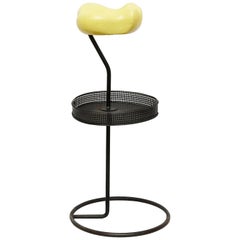Adnet Ceramique
Recent Sales
Mid-20th Century French Ceramics
Ceramic
Vintage 1950s French Mid-Century Modern Ashtrays
Ceramic
Vintage 1950s French Mid-Century Modern Ashtrays
Ceramic
Vintage 1950s French Mid-Century Modern Ashtrays
Ceramic
Vintage 1950s French Mid-Century Modern Ashtrays
Ceramic
Vintage 1950s French Mid-Century Modern Ashtrays
Steel
Vintage 1950s French Mid-Century Modern Ashtrays
Metal
Vintage 1950s French Mid-Century Modern Ashtrays
Metal
Vintage 1950s French Mid-Century Modern Ceramics
Metal
Vintage 1950s French Mid-Century Modern Tobacco Accessories
Metal
Vintage 1950s French Mid-Century Modern Ashtrays
Ceramic
Vintage 1920s French Art Deco Animal Sculptures
Ceramic, Faience
Vintage 1920s French Art Deco Animal Sculptures
Ceramic, Faience
Vintage 1950s French Mid-Century Modern Ceramics
Ceramic
Vintage 1950s French Mid-Century Modern Ashtrays
Ceramic
Vintage 1950s French Mid-Century Modern Ashtrays
Metal
Vintage 1950s French Mid-Century Modern Ashtrays
Metal
Vintage 1950s French Mid-Century Modern Ashtrays
Metal
Early 20th Century French Sculptures
Georges Jouve for sale on 1stDibs
Georges Jouve was a modern-era ceramicist with a tirelessly creative spirit. He began his career creating vases and other utilitarian vessels but soon renounced anything produced on a pottery wheel in favor of modeling and sculpture techniques. Forms found in nature inspired him to create unusual pieces — large cups that rolled up like vast seashells, curiously stylized birds — all springing from an alert imagination. He left an indelible mark as an unconventional ceramist.
Jouve was born in France, in 1910, to a family of decorators. At 17, he enrolled in the Ecole Boulle in Paris, where he studied sculpture. After graduation in 1930, he became a theater-set designer to help support his new wife and family. He only dabbled in ceramics when he had time — and that time did not present very often.
During World War II, Jouve was interned in a German forced-labor camp for his political views. He eventually escaped and hid at his stepparent’s home in southern France — where he indulged in his passion for ceramics to pass the time. In 1944, after the Germans left Paris, he returned to the city and pursued his dream of opening a ceramics studio.
Jouve’s work caught the eye of furniture designer Jacques Adnet, who asked him to participate in the Contemporary Ceramics Exhibition, which was hosted by a decorating and publishing house founded by architect Louis Süe and painter André Mare. His work was warmly received, and his pieces began to sell.
From there, Jouve started to participate in numerous exhibitions. At the 1947 Urban Planning Exhibition in Paris, he won a silver medal for a wall covering. His work was then displayed at several international traveling exhibitions presented by the French Ministry of National Education and Ministry of Foreign Affairs, from 1947 to 1950.
In 1954, Jouve left Paris to set up workshops in southern France, where he concentrated on ceramics research and new techniques. His experimentation resulted in breathtaking pieces that other artists have attempted to copy for decades.
On 1stDibs, find Georges Jouve serveware, ceramics, pitchers and more.
Finding the Right dining-entertaining for You
Your dining room table is a place where stories are shared and personalities shine — why not treat yourself and your guests to the finest antique and vintage glass, silver, ceramics and serveware for your meals?
Just like the people who sit around your table, your serveware has its own stories and will help you create new memories with your friends and loved ones. From ceramic pottery to glass vases, set your table with serving pieces that add even more personality, color and texture to your dining experience.
Invite serveware from around the world to join your table settings. For special occasions, dress up your plates with a striking Imari charger from 19th-century Japan or incorporate Richard Ginori’s Italian porcelain plates into your dining experience. Celebrate the English ritual of afternoon tea with a Japanese tea set and an antique Victorian kettle. No matter how big or small your dining area is, there is room for the stories of many cultures and varied histories, and there are plenty of ways to add pizzazz to your meals.
Add different textures and colors to your table with dinner plates and pitchers of ceramic and silver or a porcelain lidded tureen, a serving dish with side handles that is often used for soups. Although porcelain and ceramic are both made in a kiln, porcelain is made with more refined clay and is more durable than ceramic because it is denser. The latter is ideal for statement pieces — your tall mid-century modern ceramic vase is a guaranteed conversation starter. And while your earthenware or stoneware is maybe better suited to everyday lunches as opposed to the fine bone china you’ve reserved for a holiday meal, handcrafted studio pottery coffee mugs can still be a rich expression of your personal style.
“My motto is ‘Have fun with it,’” says author and celebrated hostess Stephanie Booth Shafran. “It’s yin and yang, high and low, Crate & Barrel with Christofle silver. I like to mix it up — sometimes in the dining room, sometimes on the kitchen banquette, sometimes in the loggia. It transports your guests and makes them feel more comfortable and relaxed.”
Introduce elegance at supper with silver, such as a platter from celebrated Massachusetts silversmith manufacturer Reed and Barton or a regal copper-finish flatware set designed by International Silver Company, another New England company that was incorporated in Meriden, Connecticut, in 1898. By then, Meriden had already earned the nickname “Silver City” for its position as a major hub of silver manufacturing.
At the bar, try a vintage wine cooler to keep bottles cool before serving or an Art Deco decanter and whiskey set for after-dinner drinks — there are many possibilities and no wrong answers for tableware, barware and serveware. Explore an expansive collection of antique and vintage glass, ceramics, silver and serveware today on 1stDibs.

